What is Dwarka (Dwarkadhish) temple history (information) (facts) (greatness)
Namaste friends, how are you doing today? Welcome to #BhagavanBhakthi website / blog.
Bhagavan Lord Sri Rama (Narayana) (Vishnu) (Krishna) blessings to you and your family!
In this website / blog, you will always learn about #Hinduism #Sanskrit language.
Also subscribe to my YouTube channel from this link #BhagavanBhakthi to view videos about #Hinduism #Sanskrit language.
Just before moving towards to know about “What is Dwarka (Dwarkadhish) temple history (information) (facts) (greatness)“, let us know few basic and important information.
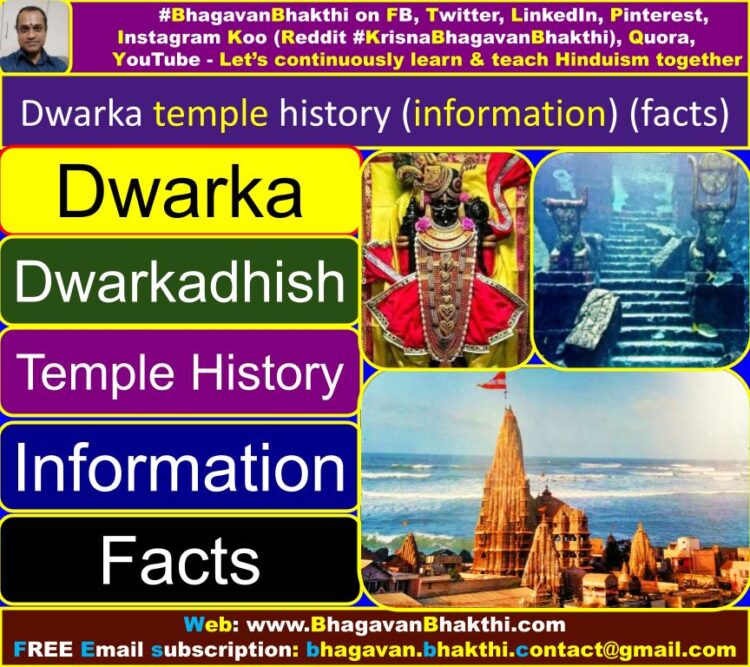
First of all, let us know the meaning of the word Dwarka (Dwaraka / Dvaraka / Dvarka) (द्वारक / ದ್ವಾರಕ / dvāraka): Here Dwarka = Dwar + Ka = Door (Gateway) + Krishna (Vishnu) (Brahma) (Brahman) (Parabrahma).
Meaning of Dwarka is: Dwarka is the door (gateway) to meet Lord Sri Krishna (Vishnu) (Rama) (Or any avatar of Lord Vishnu).
In Kali Yuga, one of the most easiest way to find Lord Sri Krishna is visiting this most divine place of Dwarka or Dwarka Puri. Here Dwarka Puri means, a place of Lord Sri Krishna. Here Puri means a divine and auspicious place.
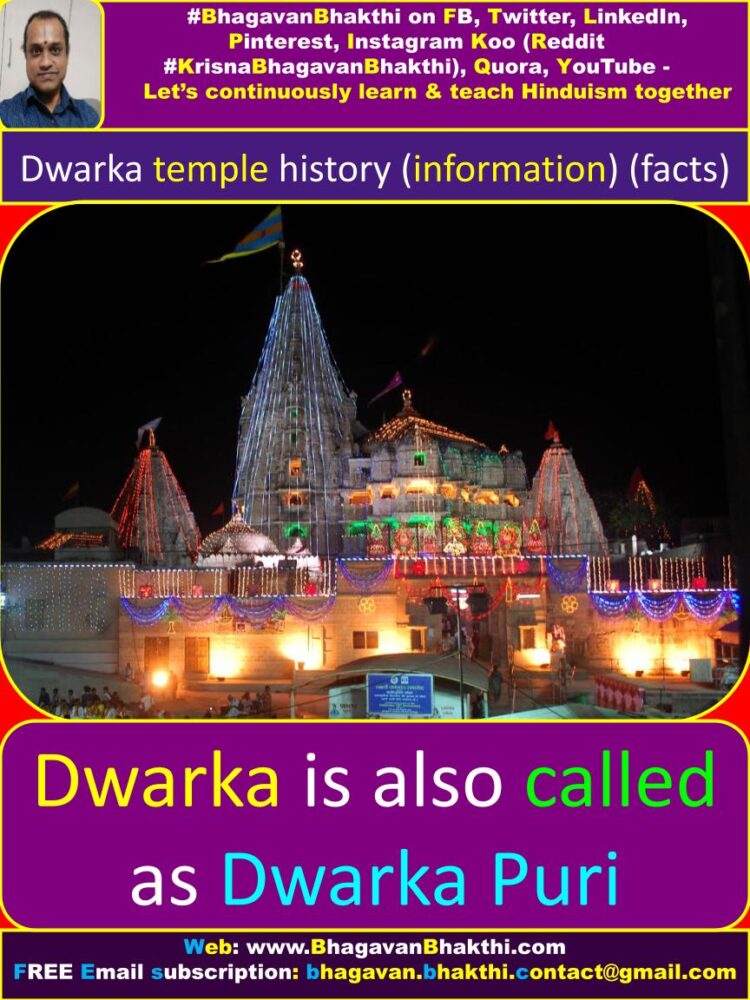
Dwarka is also alternatively spelled as Dwarika or Dvarika. Dwarka (Dvarka) is one of the Sapta Puris (seven sacred cities) in India (Sanatana Dharma) (Hinduism).
List of Dwarka (Dwarkadhish) temple history (information) (facts) are as given below:
Dwarka = Door to meet Sri Krishna | Dwarka is one of the seven tirthas of Hindus | Dwarka is situated on the banks of river Gomati | Dwarka is existing since Vedic period |
Dwarka is one of char dhams (4 divine pilgrimage places) in India | Dwarka is also known as Mokshadham or Muktidham | Brahma Manasa putras did penance here | Lord Vishnu’s chakra appeared first in Dwarka |
Later Lord Vishnu himself appeared in Dwarka | Lord of Dwarka is Chakra Narayana | Dwarka is also known as Chakra Tirtha | Goddess Ganga descended in Dwarka | Goddess Ganga in Dwarka also known as Gomati |
Dwarka is also called as Gomati Dwarka | Lord of Dwarka is also known as Sangam Narayana or Samudra Narayana | Importance of taking bath at Sangam Narayana | And many more…
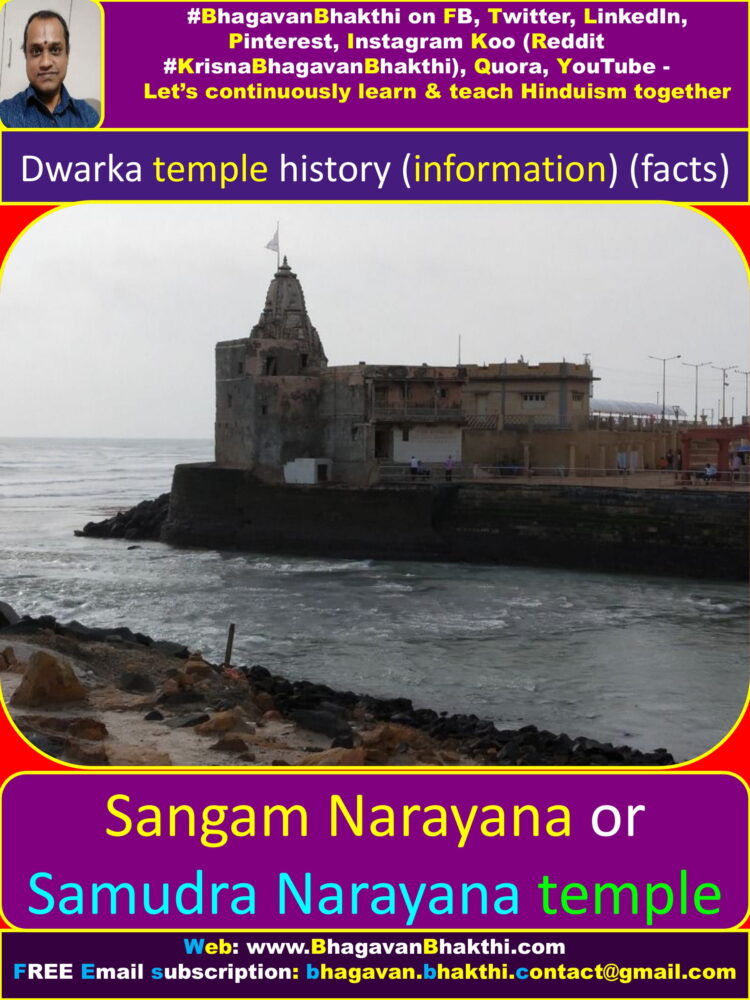
More details about “What are Dwarka temple history (information) (facts)” is as given below:
In the Hindu epics like Mahabharata, Srimad Bhagavatam (Sri Vishnu Purana) Dwarka (Dvarka) is also known as Dvaravati (द्वारकावति / ದ್ವಾರಕಾವತಿ / dvārakāvati). And as said above, this place is one of Sapta Tirtha (7 pilgrimage places) sites for spiritual liberation (Moksha).
Sapta Tirtha (Sapta Puri) (7 pilgrimage places) are: Dwarka, Mathura, Ayodhya, Kashi, Kanchipuram, Avantika (Ujjain) and Puri (Odisha).
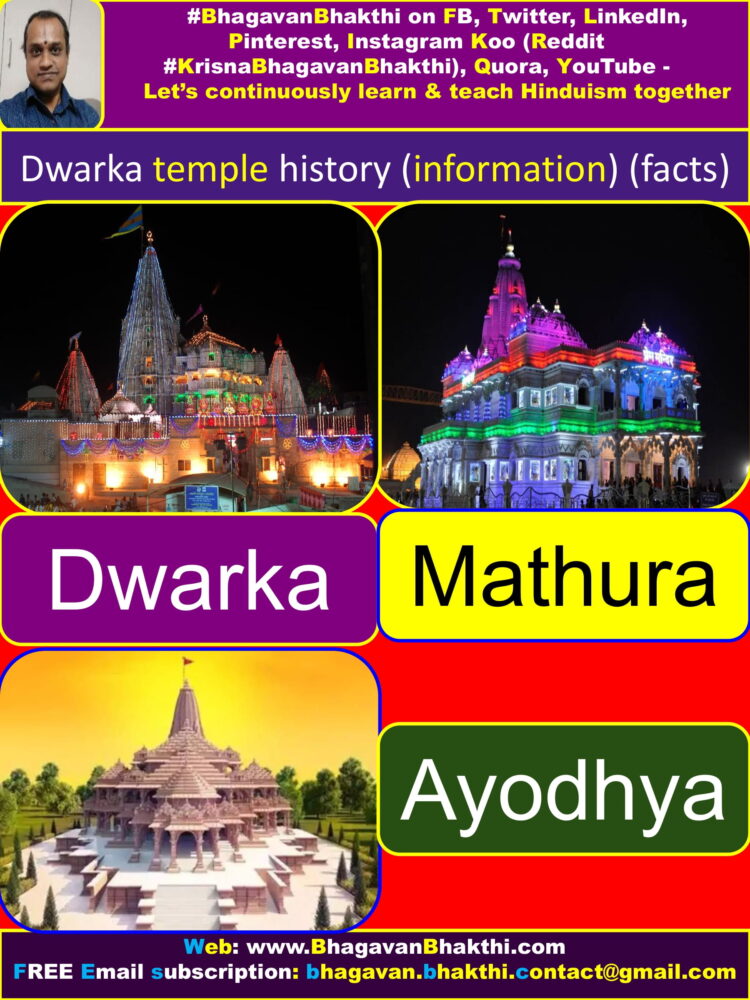
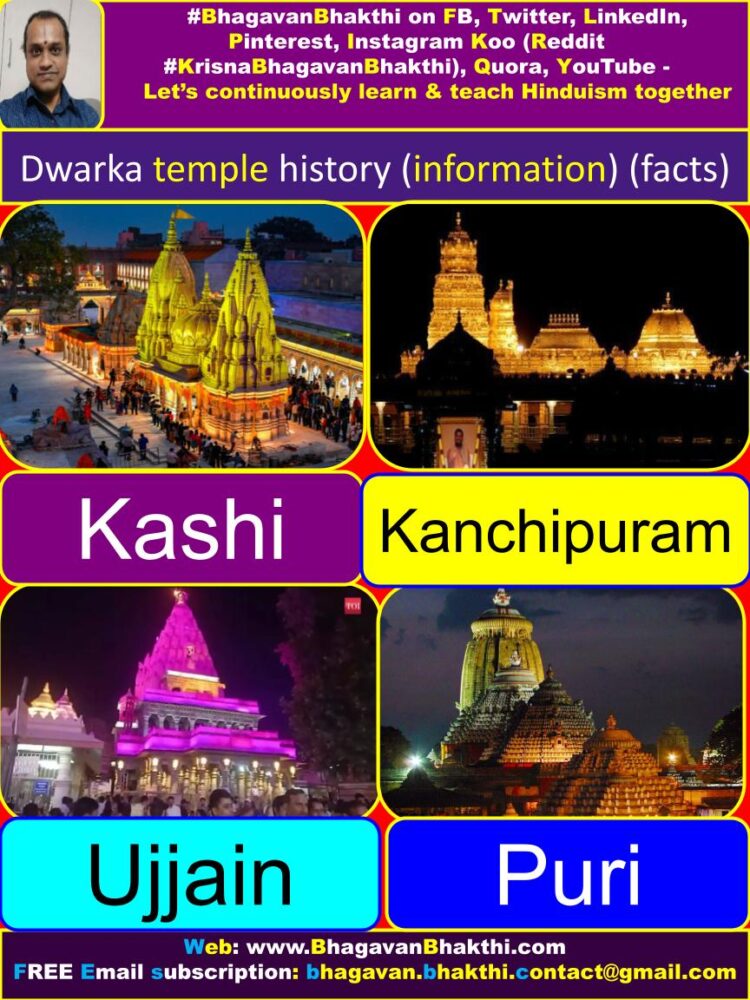
Dwaraka or Dwarka or Dvarka or Dvaraka is one of the most auspicious and divine places in India. Dwarka is situated on the far western coast of India and it is on the banks of holy river Gomati. From Gomati, it meets the western sea.
Dwarka, the great and one of the most divine place is located in the Gujarat (Saurashtra region) in Jamnagar District. It is in existence since Vedic and Puranic days with greatest and highest Sanatana Dharma importance.
Dwarka is also called as one of the Char Dhams (4 pilgrimage sites).
The four abodes (Char Dhams) (4 pilgrimage sites) of Lord Vishnu (Krishna) (God) in four directions are:
Badari (Badrinath) in the North, Rameshwaram in the South, Puri Jagannath in the East and Dwarka in the West.
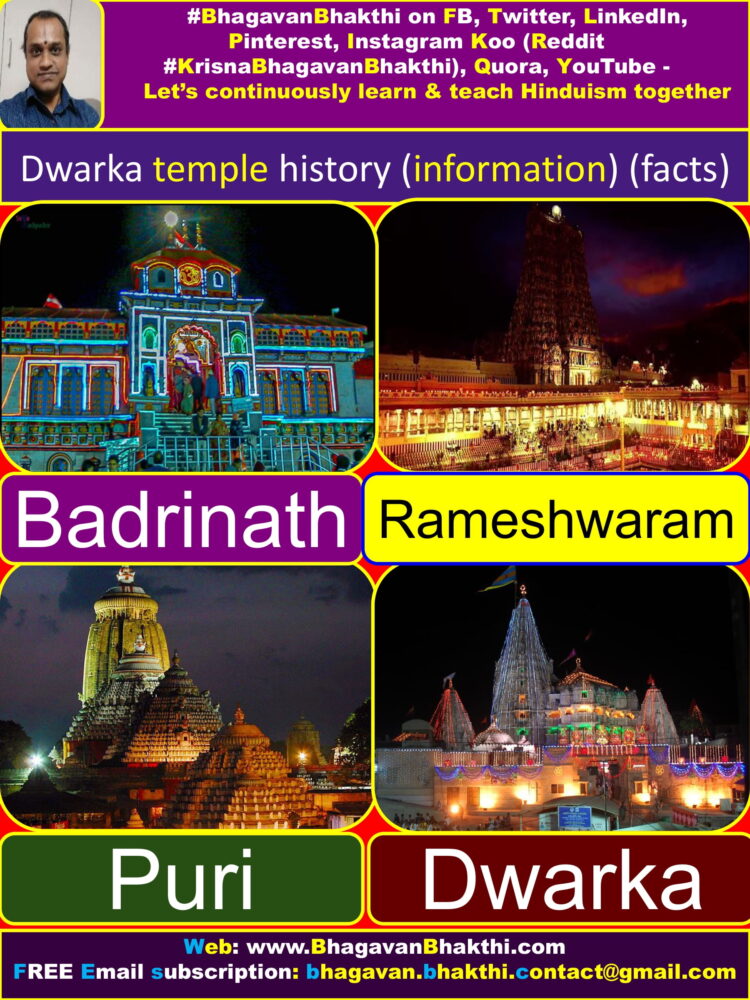
The above char dhams (four abodes or 4 pilgrimage sites) are said to be the most auspicious and revered sites for all the Hindus to be visited at least once in the life time.
As said above, Dwarak (Dwaraka) means the gateway to Brahma (Brahman) (Parabrahma), that is, the Supreme God Lord Sri Krishna.
Dwarka also has another meaning. That is, Dwarka is the gateway (door) for moksha (mukti) divine liberation of atma (soul) from actions that is liberation (moksha) from all types of Karma(s).
Hence, Dwarka is also referred to as the Mokshadham or Muktidham or Mokshapuri or Muktipuri. Dwarka is also called as Dwaravati or Dwarkavati.
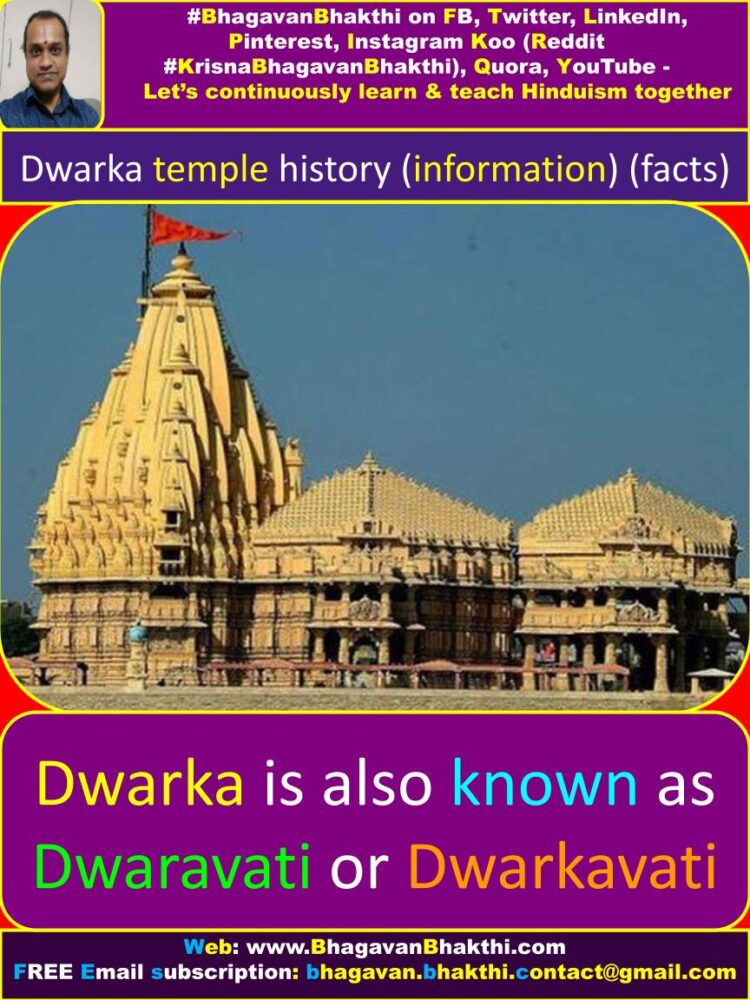
Reference to Dwarka can be easily found in many Puranic texts like Mahabharata, Srimad Bhagavatam (Sri Vishnu Purana), Skanda Purana, Harivamsha (Harivamsa) Purana etc…
It is said that Brahma Manasaputras (sons born from mind of Lord Sri Brahma), that is – Sanaka, Sananda, Sanatana, Sanatkumara (Four sons) assuming Dwarka as the site of moksha / liberation, did severe tapas / penance at this very place of Dwarka.
All these four Brahma Manasaputras did tapas (penance) for several 1,000s of years on the banks of the ocean worshipping Lord Sri Vishnu. Thus, as a result, Sudarshana Chakra the disc of Lord Sri Vishnu appeared first and later Lord Sri Vishnu himself manifested here.
Henceforth, the Lord (Bhagavan) of this place is called as ‘Chakra Narayana‘ and the entire area of pilgrimage is known as Chakra Tirtha.
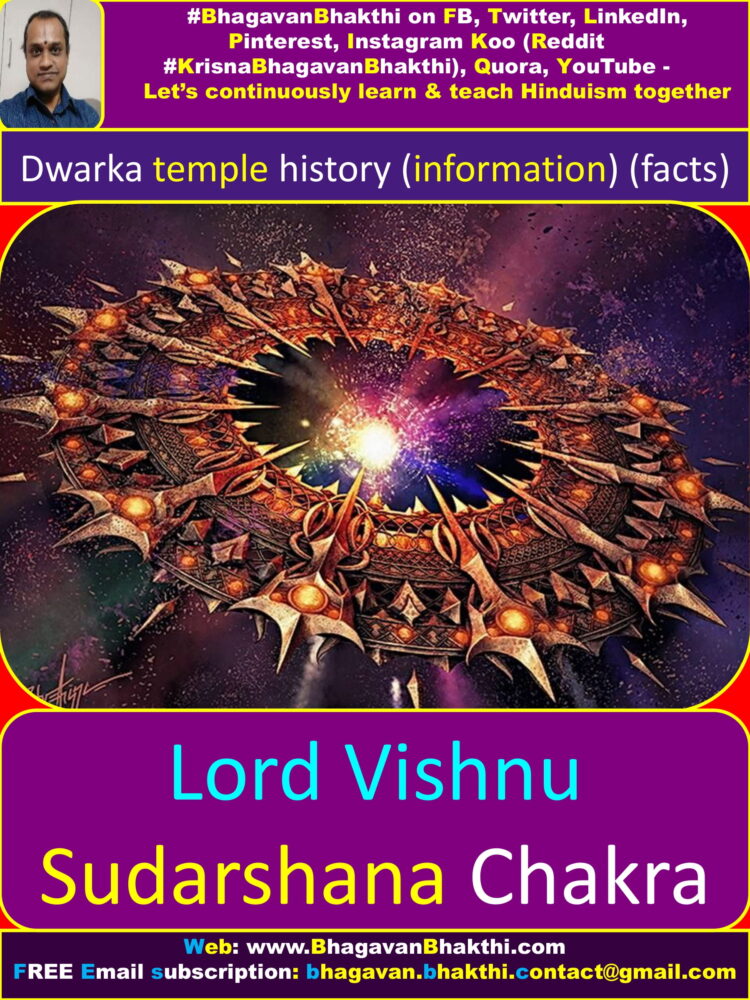
Thereafter the four Brahma Manasputras (four sages) invited Goddess Ganga to stay here in Dwarka and Ganga descended there along with the sage Maharishi Vashishtha.
The Goddess Ganga (river Ganges) flowing here is referred to as Gomati and thus, Dwarka is also referred to as Gomati Dwarka. The divine river Gomati gets merges with the ocean (Western part of India / Arabian Sea) at this place of Dwarka.
And thus the point where the river merges with the ocean is known as Gomati Sangam and for this reason, the Lord of this place has another name called ‘Sangam Narayana‘ or ‘Samudra Narayana‘.
Importance of taking bath at Sangam Narayana is as given below:
There is a great importance of taking holy bath and performing sacred rites to pitrus (ancestors) (Pinda Tarpana) (Tila Tarpana) at this divine place of Sangam Narayana point of sacred river Gomati.
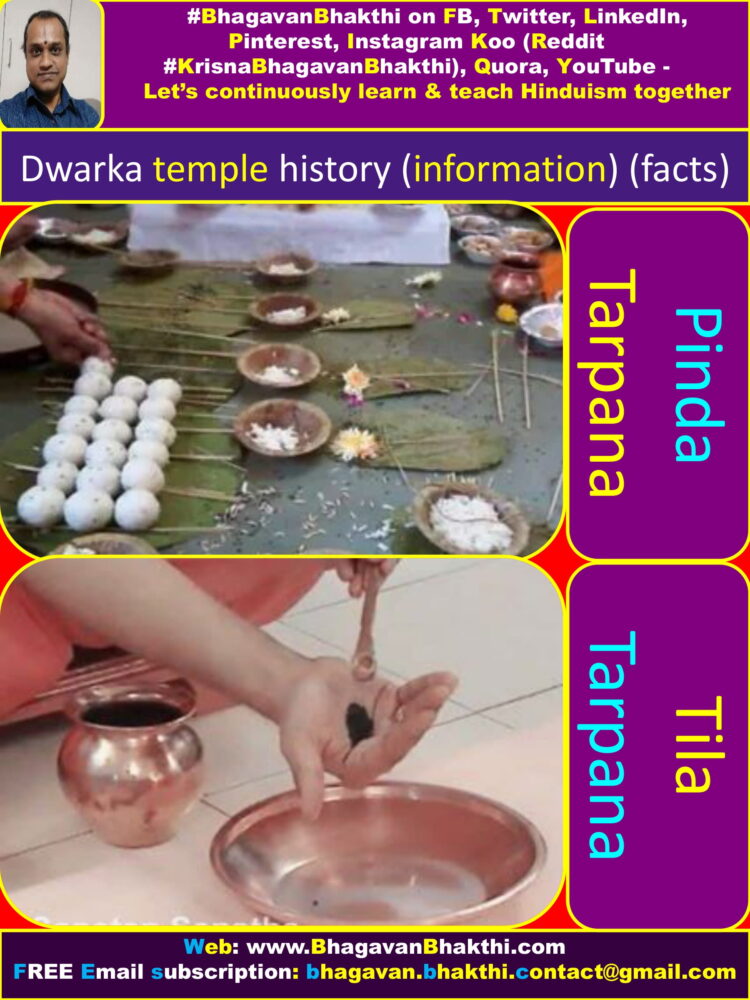
This will definitely gives the freedom from the sins committed in the present and previous births and is regarded as the gate way (Dwarka) to Moksha (Mukti / salvation).
That person’s pitrus (forefathers) belonging to three generations go to the abode of Vishnu Loka (Vaikuntha).
And his / her accumulated sins of thousands of years get destroyed immediately after that person takes bath at the Sangam Narayana.
Just mere darshanam (divine vision) of river Gomati at Dwarka destroys all the sins, which are committed by our thoughts (manasa), words (vak) and deeds (physically). It is said in Hindu texts that, during Dwapara Yuga (Sri Krishna’s period),
Sage / Rishi Durvasa came to this place of Dwarka to have darshanam (divine vision) of the Lord Chakra Narayana (Lord Sri Vishnu) who got manifested there and to take a holy bath in the sacred river Gomati.
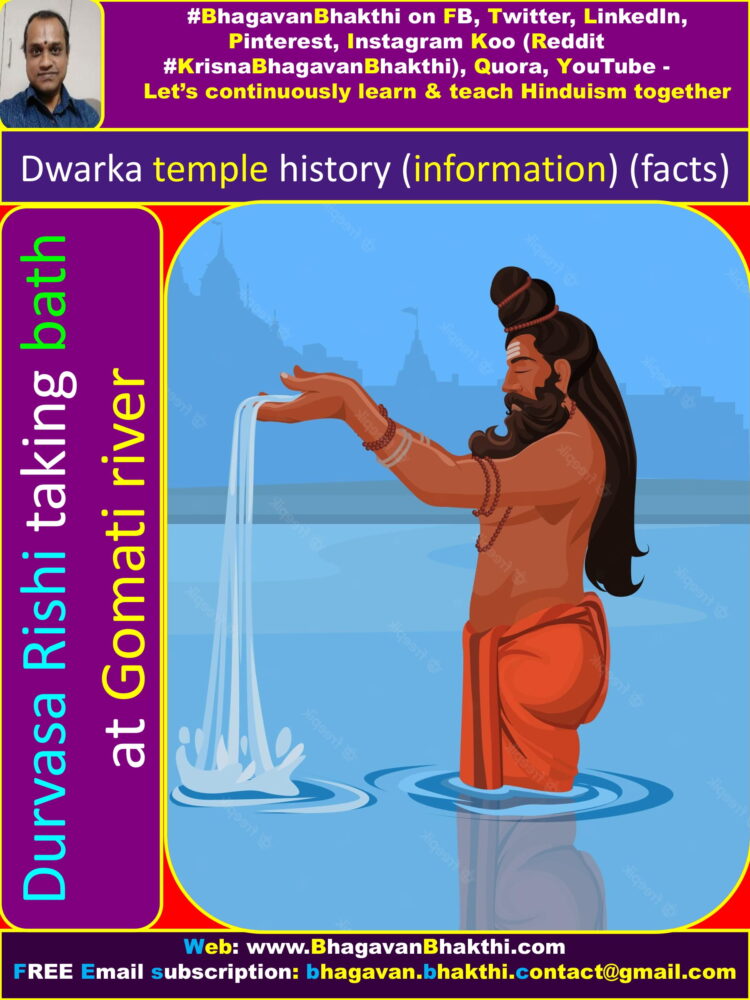
But, Rishi Durvasa was hampered by the demons there. (Rishi Durvasa is an avatar of Lord Shiva. Apart from Rishi Durvasa, Lord Shiva has taken other avatars like Ashwatthama, Shukacharya, etc.)
In Hindu texts, it is said that the Rishi Durvasa went straight to Patala Loka and informed the same to Lord Sri Trivikrama (Lord Sri Vishnu) who was fulfilling the boon given to his ardent devotee King Bali.
Immediately, Lord Sri Trivikrama (Lord Sri Vishnu) came to the rescue of Rishi Durvasa at Dwarka and for this reason this place is also known as ‘Trivikrama Kshetra‘, that is, Lord Sri Trivikrama’s place (abode).
(Here Trivikrama means, someone who has measured all the three worlds with highest ease, that is, upper planets, earth and lower planets.)
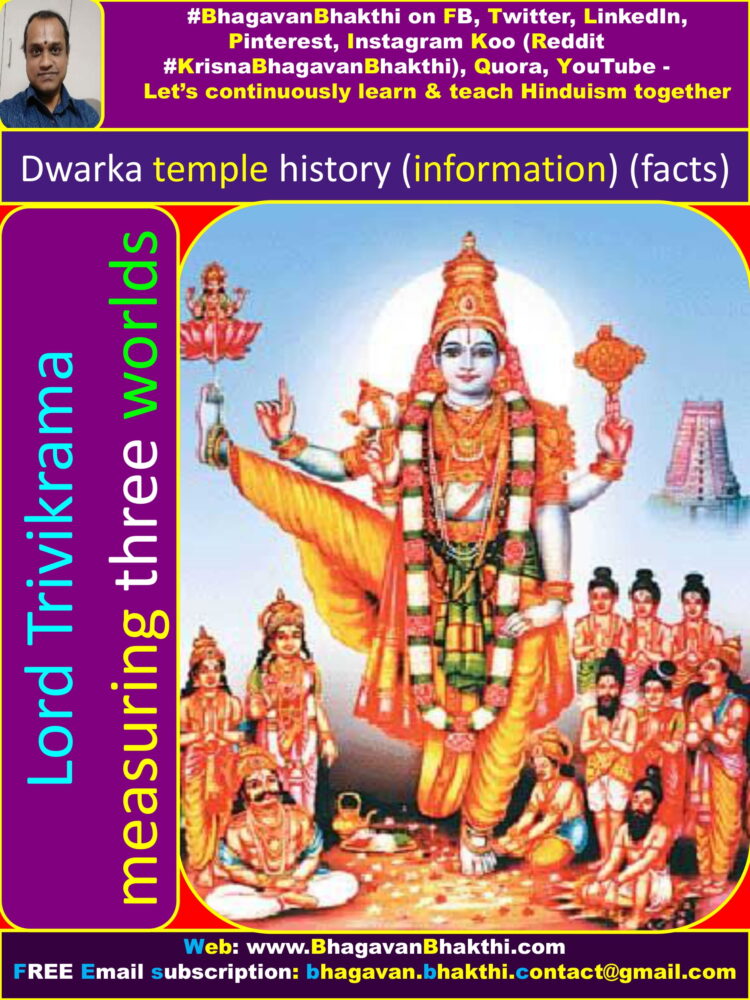
It is also highly important and auspicious place where prominent Rishis like Marichi, Atri, Angirasa etc. (apart from Rishi Durvasa) made this place as their own abode.
And these Rishis also performed several sacred tapas (penance) and austerities in this very place of Dwarka.
Why Dwarka is also called as Kushasthali:
In Sanskrit, Kushasthali = Kusha + Sthali (Sthala) = Bunch of grass (Darbha) + Sthali (Sthala) (Place).
The great Dwarka is also known as Kushasthali, that is – It’s the place where Kusha (Bunch of grass / Darbha) used by Lord Sri Brahma Deva fell on the earth, while He was taking measurement of the Earth.
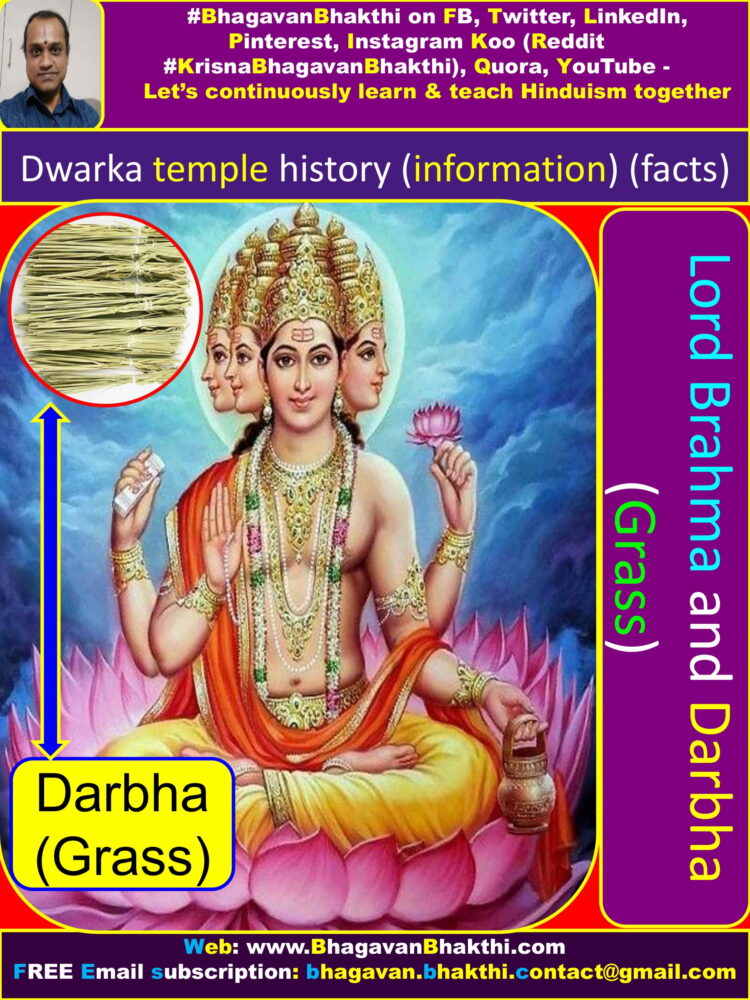
Another story of Kushasthali is as given below:
In Hindu texts, there is one more story of Dwarka also known as Kushasthali. It is said in our texts, that there used to live a rakshasa / demon called Kusha at this very place of Dwarka.
And thus, this place Dwarka was known as Kushasthali and later Lord Sri Krishna killed him at this spot and thus Dwarka is also known as Kushasthali.
The samudratat (coastal area) of western region of which Dwarka was belonged to Lord Sri Krishna’s forefathers, that is, it belonged to Yadu lineage.
Much later, during the end of Dwapara Yuga, Lord Sri Krishna shifted to this place of Dwarka and made Dwarka as his abode and capital of his kingdom.
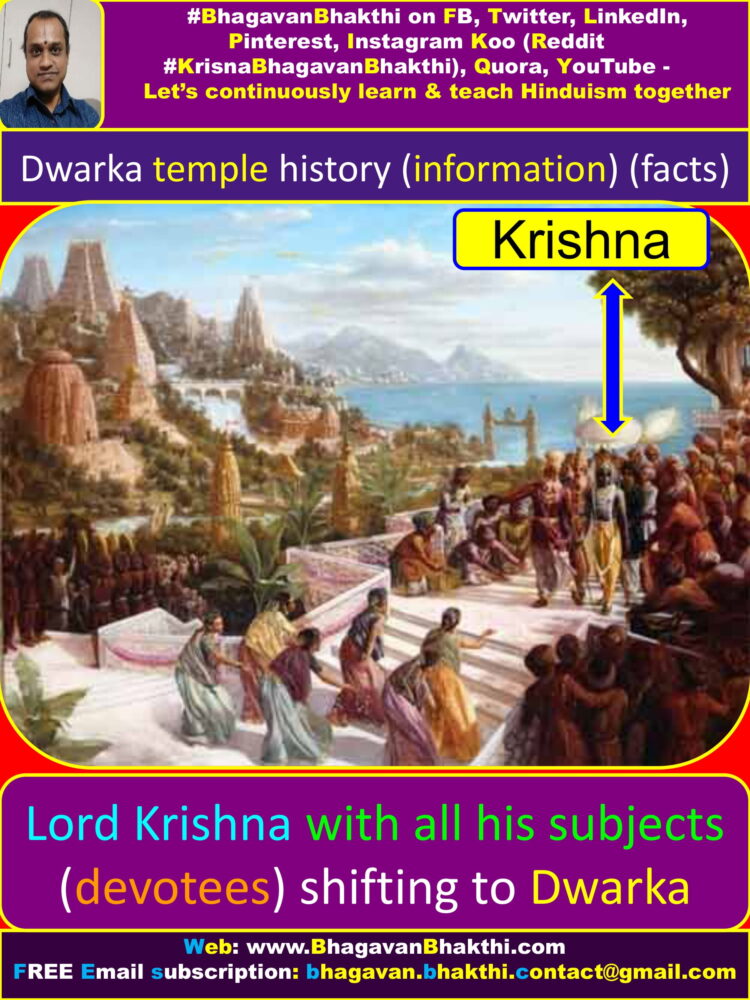
How and why Lord Krishna migrated to Dwarka from Mathura
Lord Krishna migrated to Dwarka only to protect his subjects (people) of Mathura from the indefinite and frequent attacks by Jarasandha and Kalayavana.
After Lord Sri Krishna killed his maternal uncle Kamsa, Jarasandha as he was the father-in-law of Kamsa was furious to take revenge against Lord Sri Krishna. Thus, Jarasandha indefinitely and frequently attacked Mathura as many as 17 times.
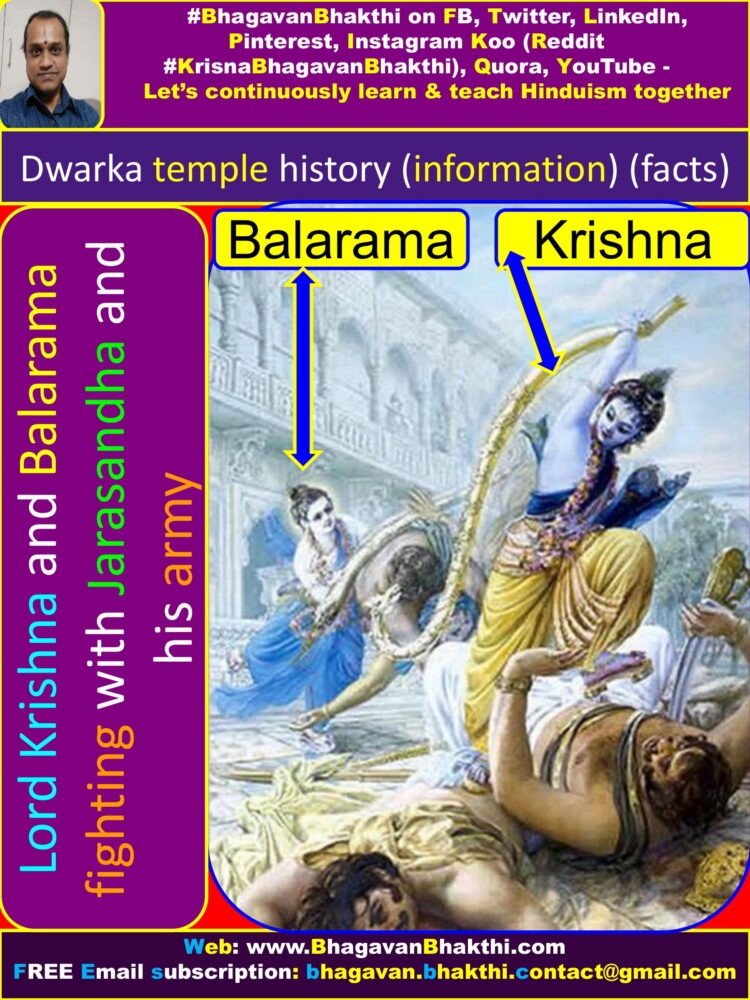
Every time Jarasandha was usually getting defeated at the hands of Lord Sri Krishna and his brother Balarama. On the 18th occasion, Jarasandha took the help of Kalayavana.
Kalayavana also got provoked from the words of Devarshi Narada and joined Jarasandha in attacking Mathura and Lord Krishna.
By this time, Lord Sri Krishna had already had the plans to move out of Mathura and was ready to shift to Dwarka considering it as the safest place for his subjects.
(Note : Kalayavana is from Yavana country as per Srimad Bhagavatam, that is, present day Yemen country).
Thus, when Mathura was attacked by Kalayavana and Jarasandha, Lord Sri Krishna with highest ease had moved to Dwarka overnight and made his subjects to feel comfortable at Dwarka.
Lord Sri Krishna’s move from Mathura to Dwarka was quite dramatic and divine. No ordinary souls can easily understand this situation of shifting from Mathura to Dwarka.
Only great souls and with the blessings of Lord Sri Krishna can only understand this situation. After the shifting, Lord Sri Krishna came back to the war field at Mathura. While Balarama was confronting with Jarasandha, Lord Sri Krishna took on Kalayavana.
Lord Sri Krishna faced Kalayavana without carrying any weapon(s) and came to the war field by barehanded. Lord Sri Krishna, instead of fighting with Kalayavana, pretended as if He is running away from the war field and provoked Kalayavana to catch him.
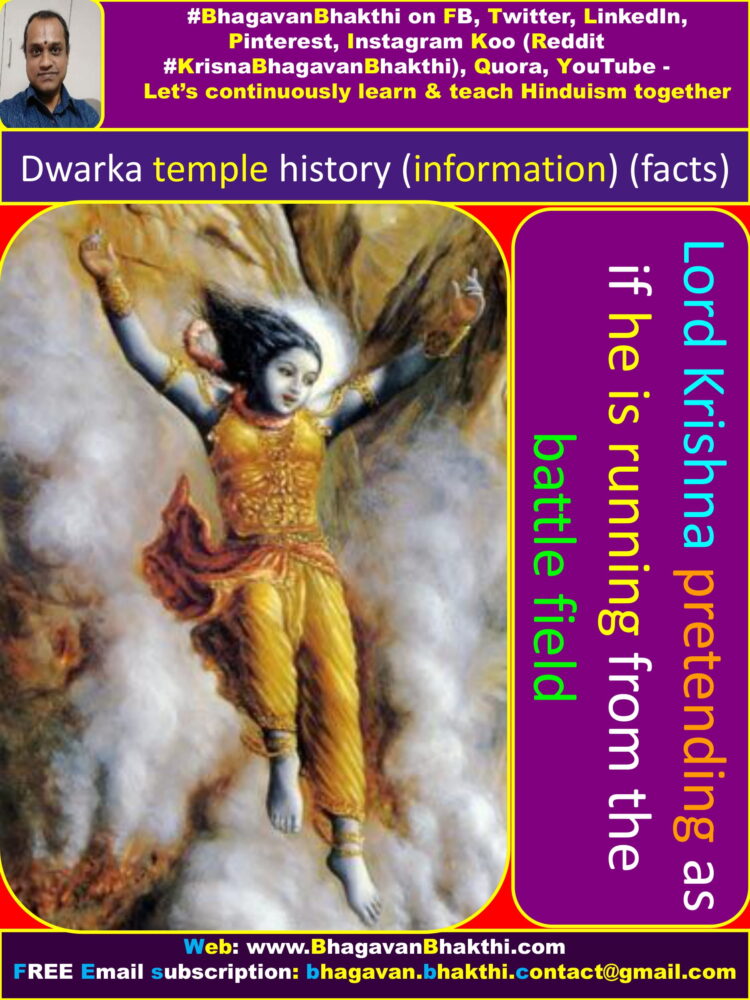
Kalayavana with all furiousness chased Lord Sri Krishna assuming that Lord Sri Krishna is indeed really running away from the battle field and war.
Lord Sri Krishna in the process was moving towards Dwarka, entered into a dark cave on the way and hided himself behind a man who was looking like a Rishi / Sage and who was in deep sleep.
The Rishi / Sage was none other then great King Muchukunda of Suryavanshi (Solar Dynasty) family. Lord Sri Krishna pulled his own upper cloth (Pitambaram / Golden yellow cloth) and spread it on the King Muchukunda.
Chasing Lord Sri Krishna, Kalayavana entered that dark cave and mistook the person sleeping there as Lord Sri Krishna and hit him with his leg disturbing King Muchukunda from his deep sleep.
When King Muchukunda got disturbed and awakened, he got up from his deep sleep and opened his eyes. Soon Kalayavana standing in front of Muchukunda got burnt into the ashes, because of the fire emanated from Muchukunda’s eyes.
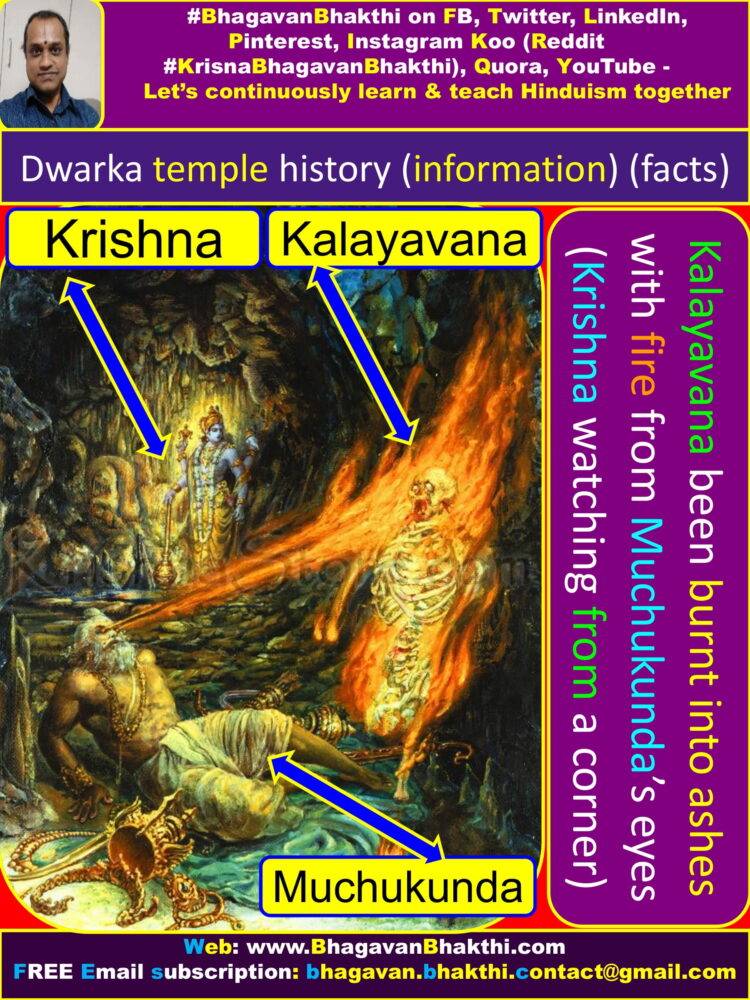
Thus, Lord Sri Krishna easily got rid of his mighty enemy Kalayavana with his divine trick and in the process crossed the border and migrated to Dwarka forever.
Since this mode of his migration looked like that Lord Sri Krishna pretended running away from the war field, Lord Sri Krishna is thus also called as Ranchod, that is, someone who fled away from the war without fighting his enemy.
But, it should always be noted that, this is just a Leela / drama (pastimes) of Lord Sri Krishna apart from Kalayavana also had a boon from Lord Shiva that, he will not get killed by any of the Yadavas.
Lord Sri Krishna who knows anything and everything, had to use King Muchukunda in this process and also utilized his (Muchukunda’s) boon in getting Kalayavana killed.
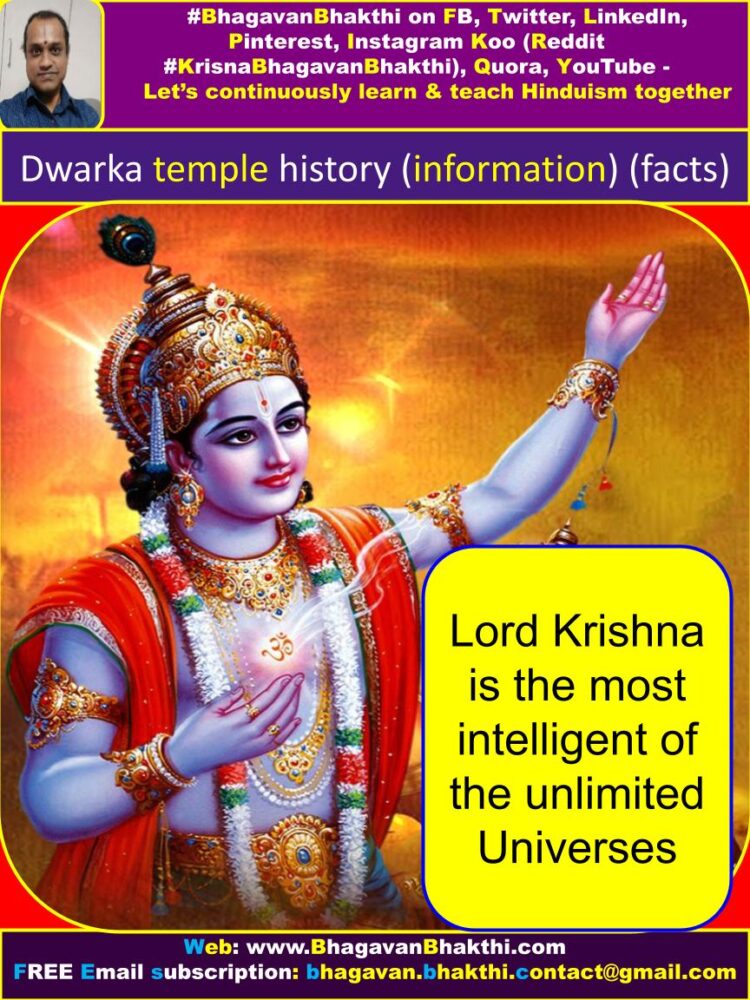
Background story of King Muchukunda is as given below:
King Muchukunda was belonging to Suryavanshi Dynasty (Solar Dynasty), where Kings like Ikshvaku, Manu, Raghu, Mandhata, Lord Rama, etc. have ruled this earth since unknown age.
King Muchukunda, during his time had helped a lot to the Devatas (Demigods) in their war against Asuras (Demons). Thus, as a result of which Devatas (Demigods) wanted to give him King Muchukunda a boon.
For this, King Muchukunda asked Moksha (Liberation) as a boon, but the Devatas (Demigods) expressed their inability on this matter.
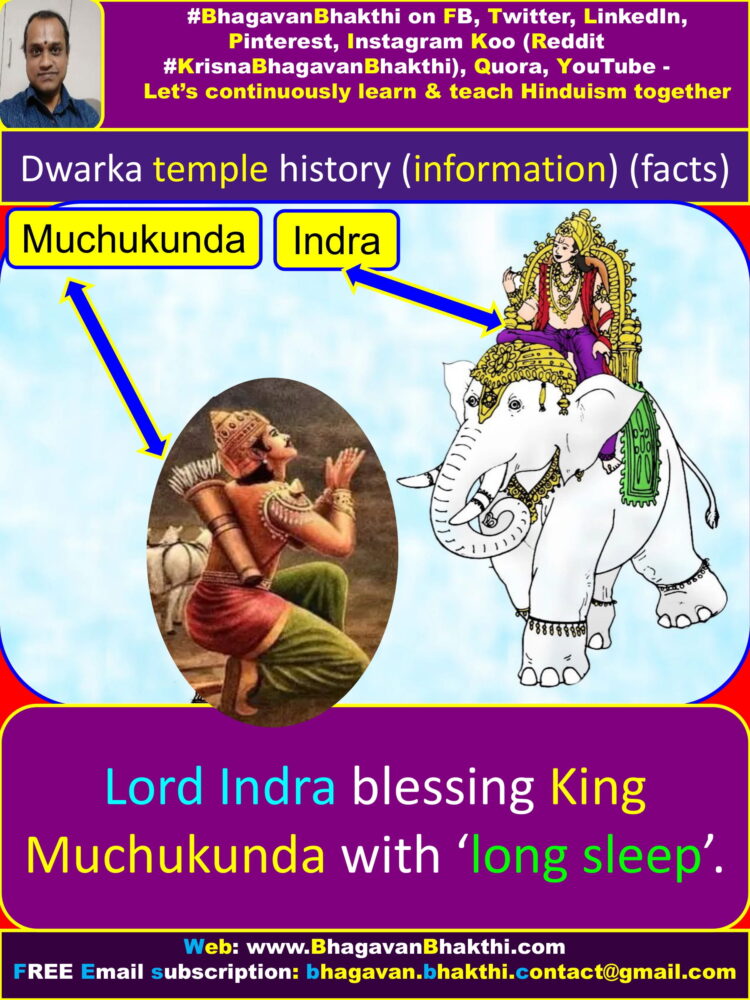
Only Lord Srimann Narayana (Vishnu / Hari / Rama / Krishna) is capable and empowered to give Moksha (Liberation) to anyone.
For this, King Muchukunda asked for a boon of deep and undisturbed sleep for a very very long time which was accorded on him by Devatas (Demigods).
Beside this, King Muchukunda was also blessed that whoever disturbs him in his sleep will get reduced into ashes from his one glance (through eyes).
In Dwapara Yuga, King Muchukunda’s deep sleep was disturbed by Kalayavana and his (Muchukunda’s) one glance reduced Kalayavana into mere ashes.
In the process, King Muchukunda had the darshanam (divine vision) of Lord Sri Krishna, an avatar of Lord Vishnu, the Supreme personality. Lord Sri Krishna blessed King Muchukunda with Moksha (liberation) in his next birth.
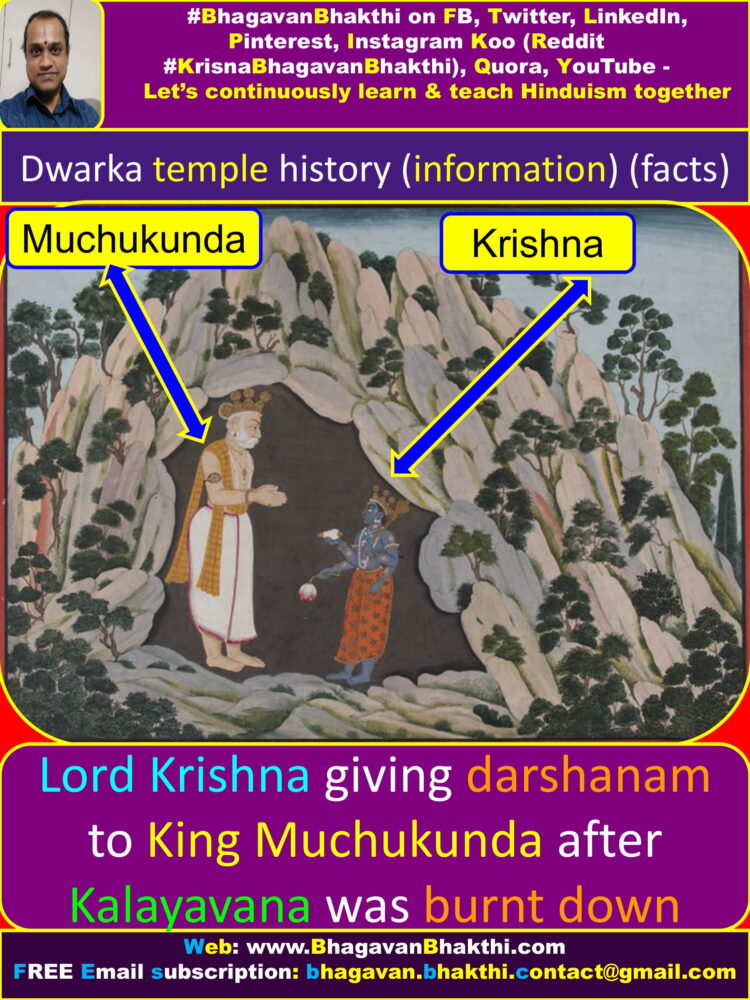
And Lord Sri Krishna advised him (Muchukunda) to take up penance and accordingly he went to Badrikashram (Badrikashrama) (Badrinath) (Badrinatha) for performing penance.
We can find this story of King Muchukunda and Kalayavana in Srimad Bhagavatam in the 10th chapter (Dashama Skanda). When Lord Sri Krishna wanted to move to Dwarka and also wanted to construct a city, in that place there was full of water and forest all around.
For this reason, Lord Sri Krishna requested Lord Varuna (Samudra / Lord of the ocean) to move back 12 yojanas (approx. 108 square miles).
Later, the Devatas (Demigods) Architect cum Engineer, that is, Vishwakarma constructed the most beautiful, most magnificent, most glorious and majestic city called Dwarka on this land within no time.
Thus, after the construction of the Dwarka city, Lord Sri Krishna settled along with his subjects in Dwarka forever.
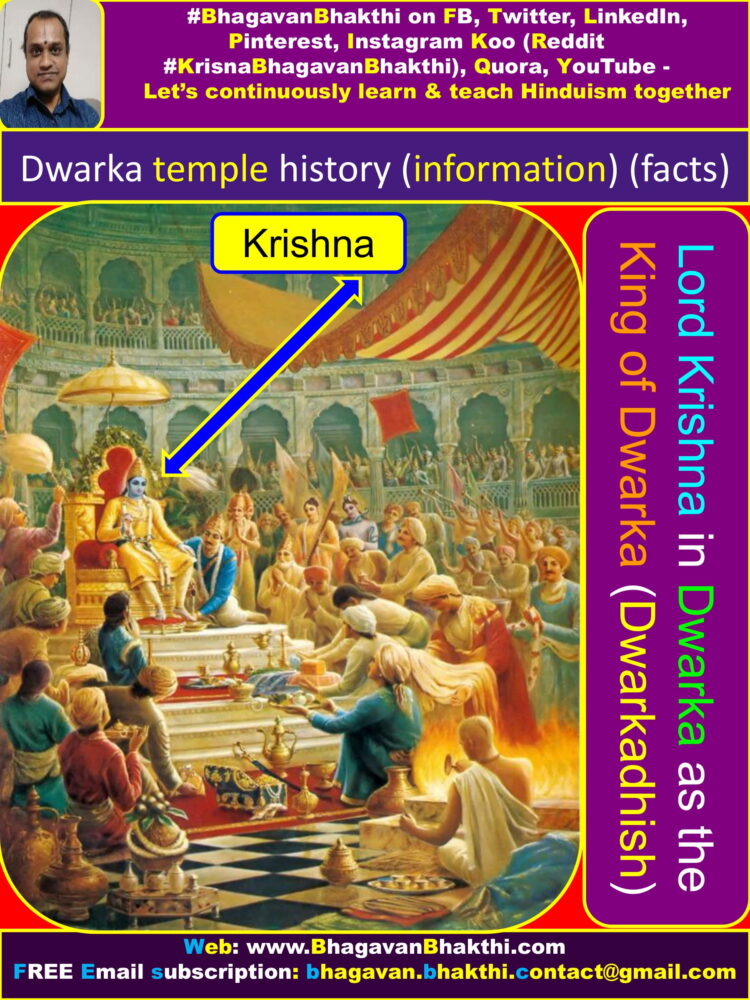
It is said in the Srimad Bhagavatam that, Lord Sri Krishna physically lived in Dwarka until 106.6 years with all his great majesty and prowess till his Niryana (Going back to Vaikuntha).
Lord Krishna’s era in Dwarka is considered as the Golden period of Dwarka and for this reason, Dwarka is called as the ‘Svarna Nagari‘ (Golden city) on earth. Dwarka was the capital of Lord Sri Krishna’s kingdom from where He used to administer his government.
While Beyt Dwarka an island 35 km away from Dwarka was His residence. From Beyt Dwarka, Lord Sri Krishna used to live with all his divine Bharyas (Consorts).
With the Niryana (Going back to Vaikuntha) of Lord Sri Krishna the legendary city of Dwarka got fully submerged along with its glory more than 5000 years back.
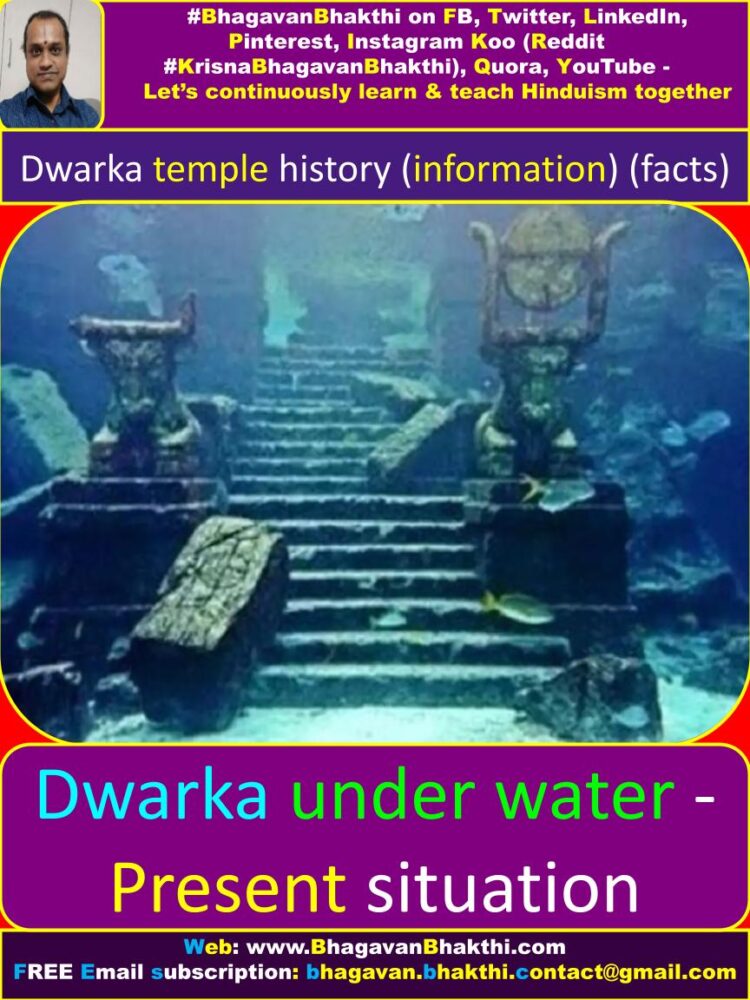
Thus from that time, Dwarka has submerged six times and the present city of Dwarka in Gujarat is the 7th such version built in that area. Though the original and divine Dwarka is not present today, it is said to be the same land where the legendary Dwarka existed.
From the archeological survey, it is believed and said that the remains of the original Dwarka are still present deep in the oceans.
Lot of research work has been done in this regard and some of the evidences have been unearthed and very much proved that the divine city of Dwarka as indeed present 5k years back.
Dwarka is surrounded by many other auspicious and celestial places like Somnath, Beyt Dwarka, Nageshwar, Harsiddhi Mata temple etc. Sunset view at Dwarka is highly divine and worth seeing.
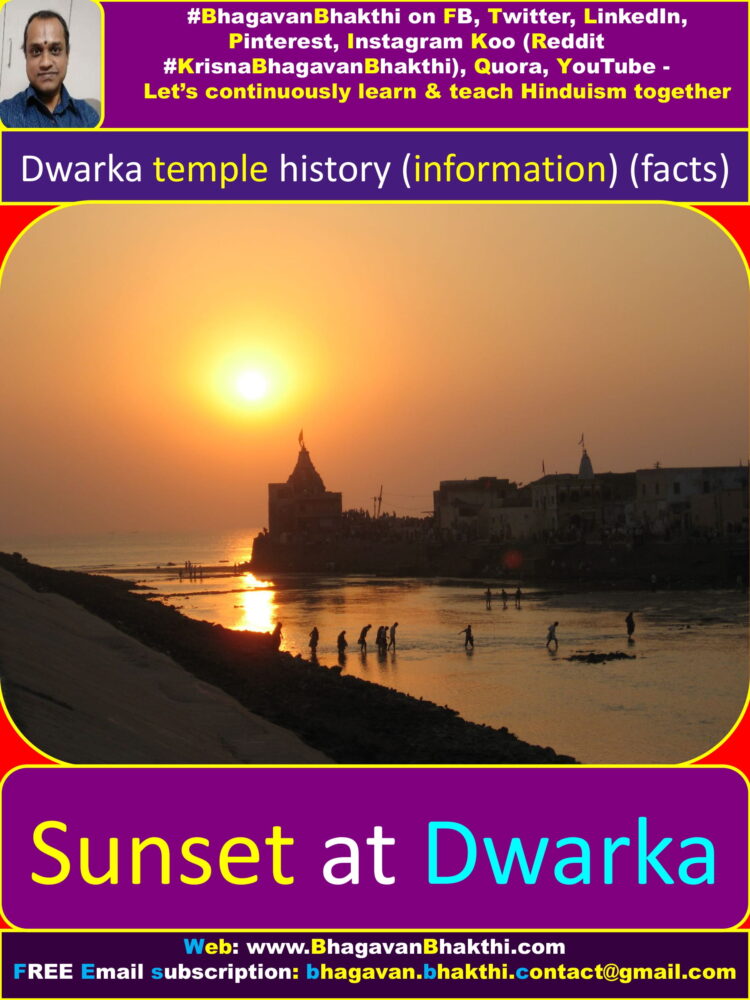
Dwarka is also the seat of one of the four spiritual centers “Sharda Peeth” (Sharada Peetham) established by the Hindu Philosopher and Saint Sri Adi Shankaracharya.
Just a mere thought in mind of going on a pilgrimage to Dwarka in a person’s mind is said to liberate his / her pitrus (forefathers) from their sins and hell.
Providing food to a person (people) going on a pilgrimage to Dwarka is said to give virtues similar to that of performing Shraaddha (Shraddh) (श्राद्ध / ಶ್ರಾದ್ಧ / śrād’dha) at Gaya.
Giving danam (charity) at Dwarka or on the way to Dwarka, listening to the divine stories, songs in praise of Lord Sri Krishna:
Is highly meritorious and one will surely receive the blessings of Lord Sri Krishna, who is also known as Dwarkadhish (Dwarkadhisha). Go-danam (Donation of cows) at the banks of river Gomati is said to yield highly meritorious results.
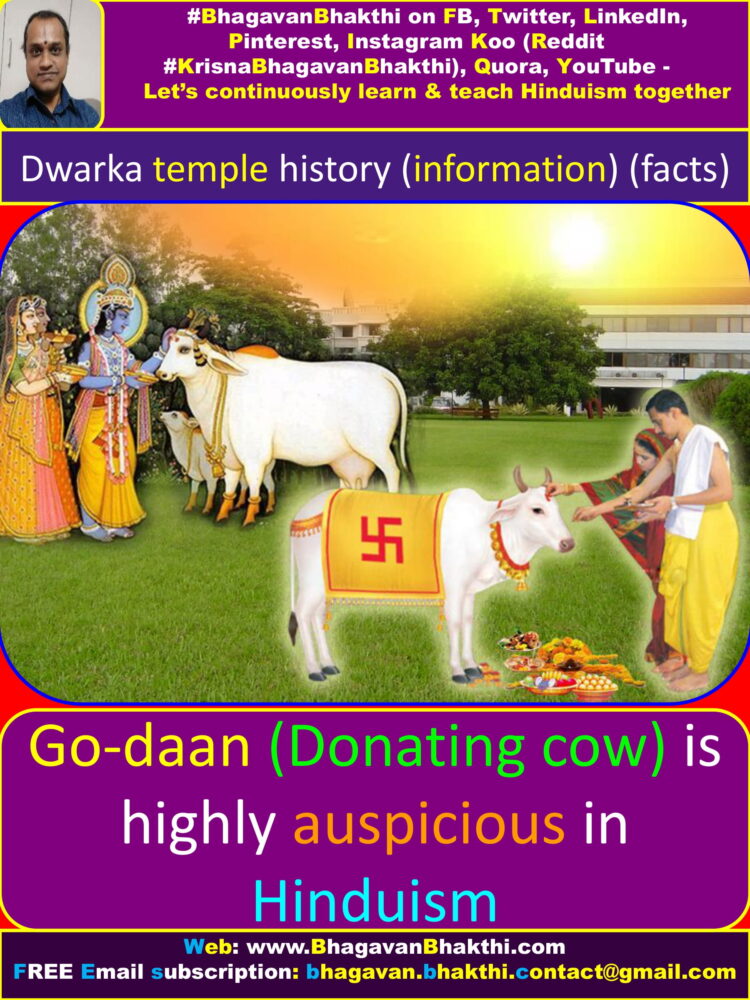
It is said in Hindu texts that, Gomati darshanam (divine vision of Gomati river), Gomati Snanam (divine bath at Gomati river), Go-danam (donation of cow),
Gopichandanam (divine sandalwood) and Gopinatha (Gopinath) (Lord Sri Krishna) darshanam (divine vision) at Dwarka are very auspicious, rare, holy, celestial and highly meritorious.
Only blessed and divine people can live in Dwarka and one who gets an opportunity to see the face of Lord Sri Krishna (Dwarkadhish) at Dwarka at least once in their life time.
With all its great grandeur Dwarka is standing as an epitome of Hindu Dharma, religion and culture attracting unlimited pilgrims from across the globe since ages.
One story about Dwarka is as given below:
Once, few sages asked Sutaji about the means by which Lord Sri Vishnu could be realized in Kaliyuga – the era dominated by sin and decaying moral values.
Sutaji started by describing how Lord Sri Vishnu on seeing the prevalence of sin in Dwapara Yuga had to take incarnation as Lord Sri Krishna to liberate the world from the sinners.
Sutaji also described in detail all the incidents culminating into the killings of many cruel demons – Kaliya serpent, Chanura, Shishupala and ogress like Putana and others.
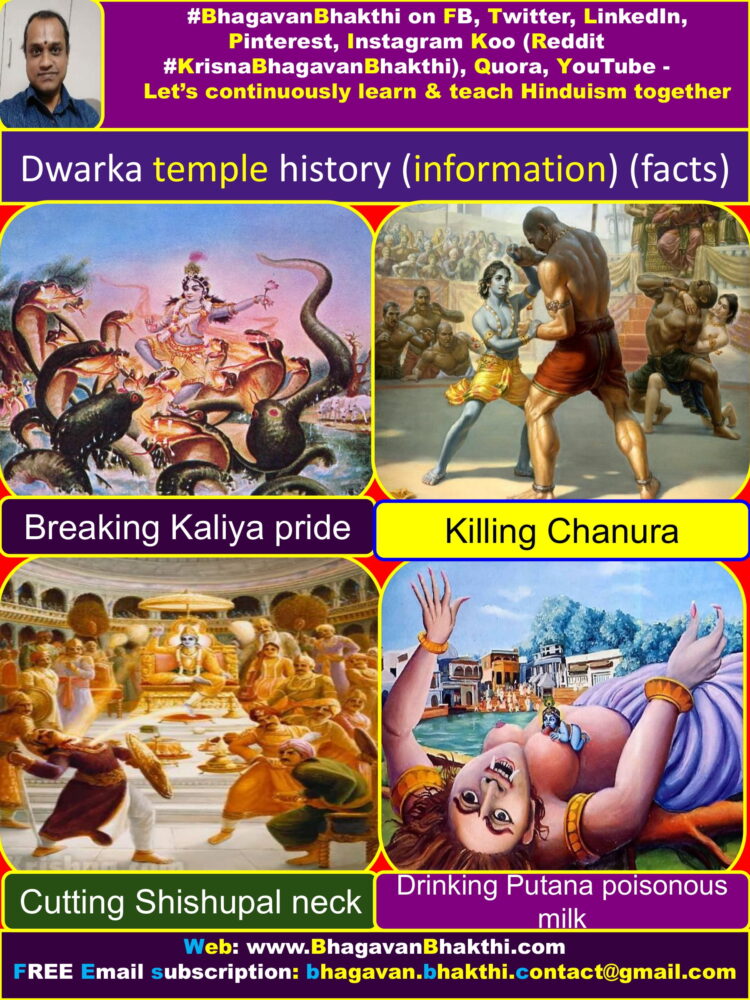
Sutaji gave in depth description of the events leading to the war of Mahabharata and how the infighting among the mighty Yadavas led to their own destruction.
Sutaji told them how a fowler (Jara – in earlier life he was Maharshi Bhrugu) mistook Lord Sri Krishna’s feet to be of a deer. Sutaji also told the assembled sages how the magnificent city of Dwarka had been submerged in the ocean ultimately.
Sutaji revealed to them after Lord Sri Krishna left this earth, how it marked the advent of Kali Yuga and the situation became even worse.
[But still Kali (कली / ಕಲೀ / kalī) was not able to completely show his powers, because of the presence of Parikshit Maharaja.]
On finding how difficult it was to realize Lord Sri Vishnu in the Kali Yuga – the era dominated by sin, some prominent sages decided to seek Lord Sri Brahma Deva’s help in this regard.
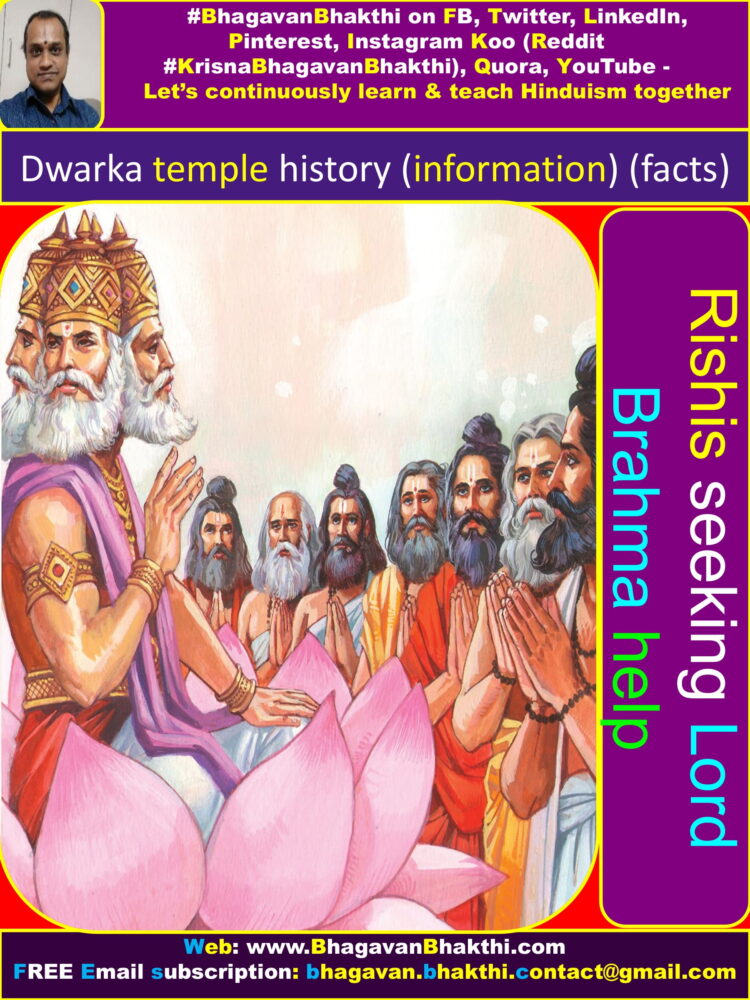
After reaching Brahma Loka, they eulogized Lord Sri Brahma Deva and received his blessings.
Lord Sri Brahma Deva told them to go to Patala loka and meet Prahlada, one of the supreme devotee of Lord Sri Vishnu who according to Lord Sri Brahma Deva was in a better position to help them.
All the sages went to Patala loka as per the instructions given by Lord Sri Brahma Deva. There they not only found Prahlada, but also the most charitable king Bali Chakravarti (Mahabali) (grand son of Prahlada).
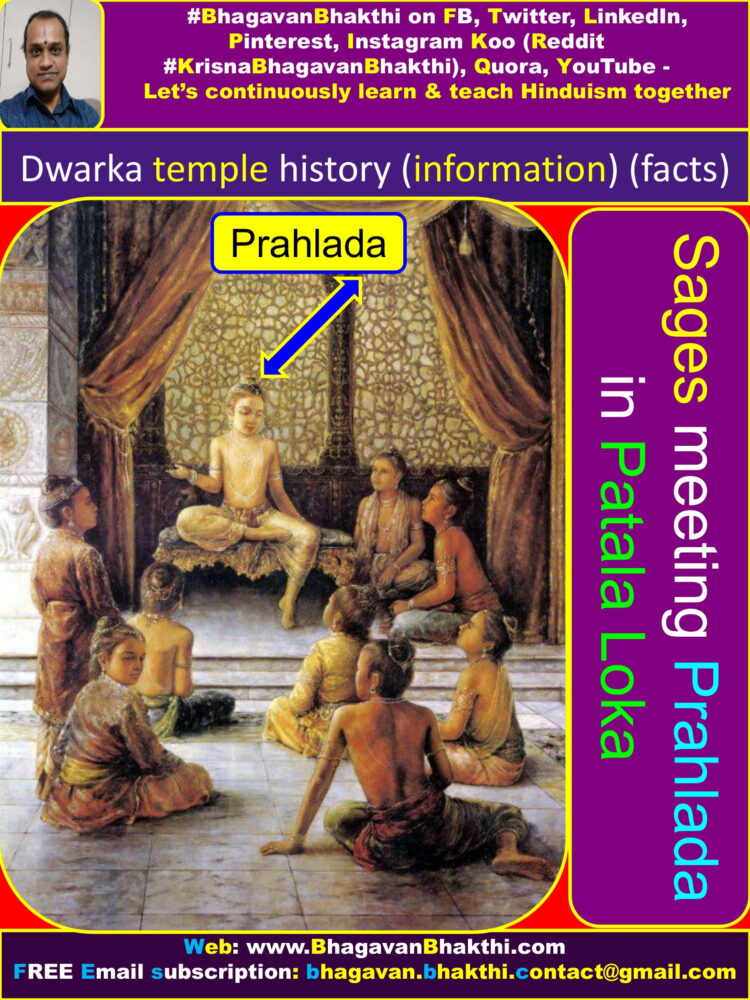
After the pleasantries were exchanged, they came to the real issue and said:
‘We are very much distressed by the prevailing situation where it appears that the evil forces have overshadowed the virtuous ones.’ ‘The ways shown by the Vedas are no longer in practice and the Brahmins are being tormented by the Shudras, who have become the rulers.’
‘We have come with a request and a desire to know whether there was any possibility of realizing Lord Sri Vishnu in this dark era of ‘Kali’.’
‘If yes then where can we find Lord Sri Vishnu?’
The sanctity of Dwarka Puri: Prahlada, being an ardent devotee of Lord Sri Vishnu himself, understood quite well, the desperation with which a devotee seeks his Bhagavan (Lord Vishnu).
So Prahlada told them – ‘By the grace of Almighty Lord Sri Vishnu, I am revealing to you the name of that sacred place which has remained a secret till now.’ ”Kushasthali (Kushasthala) Puri‘ (Dwarka Puri) is a divine city situated on the western coast.’
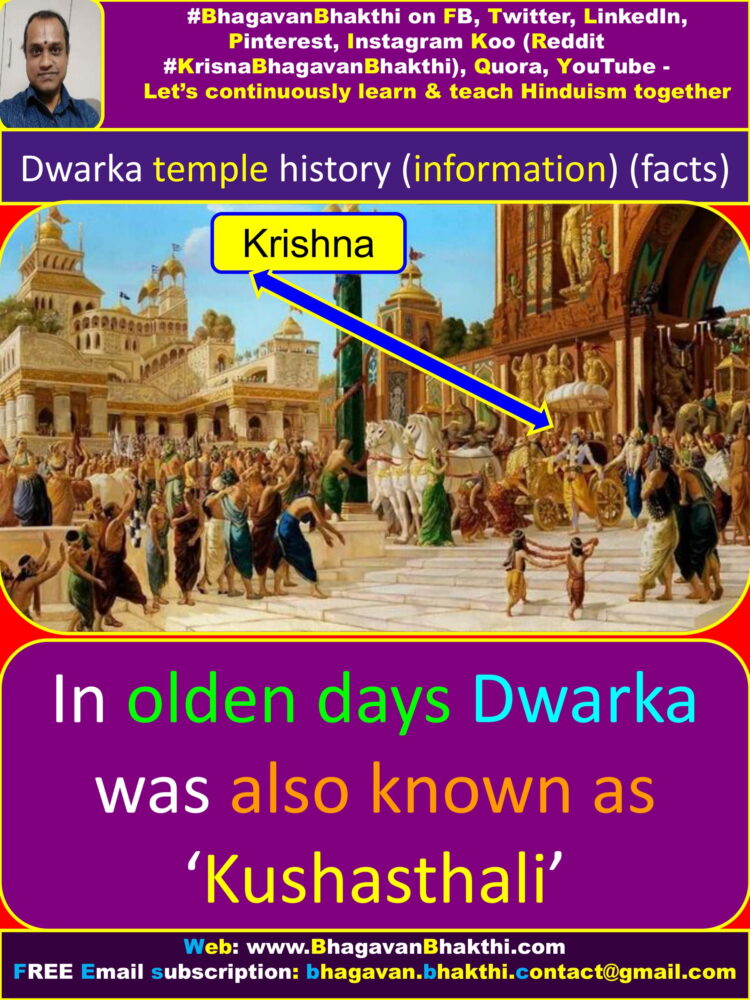
‘Nearby is the place where river Gomati meets the ocean and at this convergent point is situated the sacrosanct city called Dwarka Puri, where you can find Lord Sri Vishnu in all his glory of sixteen kalas.’
‘Blessed be the Dwarka Puri, which The almighty Lord Sri Vishnu has chosen as his abode and where he dwells in his glorious of Chaturbhuja form.’ ‘This is the very place, which even liberates the most fallen sinner from all his sins.’
‘There is a famous temple of Lord Sri Trivikrama (another name of Lord Sri Vishnu) at the bank of river Gomati and not far from this temple is a divine pond.’ ‘Anybody desirous of salvation (Moksha) must bathe in this pond for the fulfillment of his wish.’
‘It is believed that before leaving for Vaikuntha, Lord Sri Sri Krishna had transferred all his divine powers into the Sri Trivikrama idol.’
‘So, there is no place as holy as Dwarka (Dwaraka) and if you are desirous of having a divine glimpse of Lord Sri Krishna, then you must visit Dwaraka.’
All the sages thanked Prahlada for sharing his secrets with them because nobody else, except Prahlada was aware of the fact that Lord Sri Vishnu had given Dwarka the privilege of being his abode.
These revelations made them more curious about Dwarka, so they requested Prahlada to disclose how the holy Gomati descended down to Dwaraka?
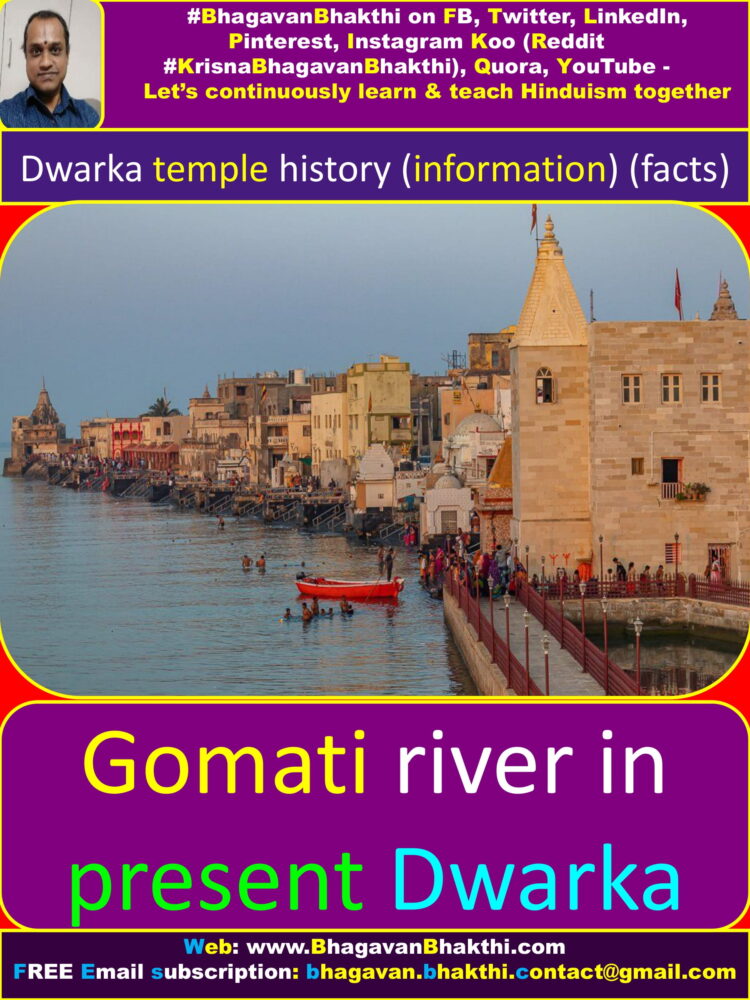
Prahlada began by describing the virtues of going on a pilgrimage to Dwarka – ‘The mere resolution of going on a pilgrimage to Dwarka is enough to liberate one’s ancestors from the tortures of the narakas.’
‘Each step that a devotee takes towards Dwarka gives virtues similar to what is attained by performing Ashwamedha yagna.’ ‘One who encourages others to go on a pilgrimage to Dwarka certainly goes to Lord Sri Vishnu Dham.’
Prahlada then switched over to the second part of the sages’ question and said – ‘There is an interesting tale describing how sage Vashishtha Maharishi had brought down Gomati from the Svarga Loka to earth.’
‘At the time of deluge, when the whole world had submerged in water, a lotus flower manifested from Lord Sri Vishnu’s navel on which was seated Lord Sri Brahma Deva.’
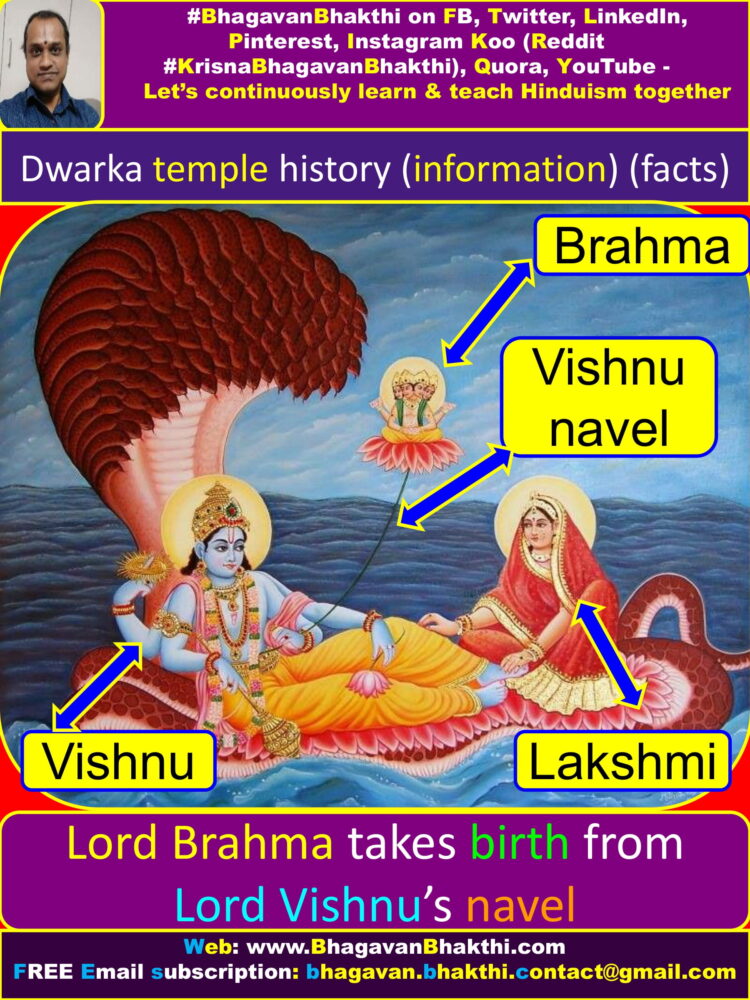
‘Lord Sri Vishnu instructed him to perform his duty as a creator to which Lord Sri Brahma Deva agreed.’
‘First of all Lord Sri Brahma Deva created his ten Manasaputras (Sanaka, Sanatana, Sanandana, Sanata Kumara, etc.)’
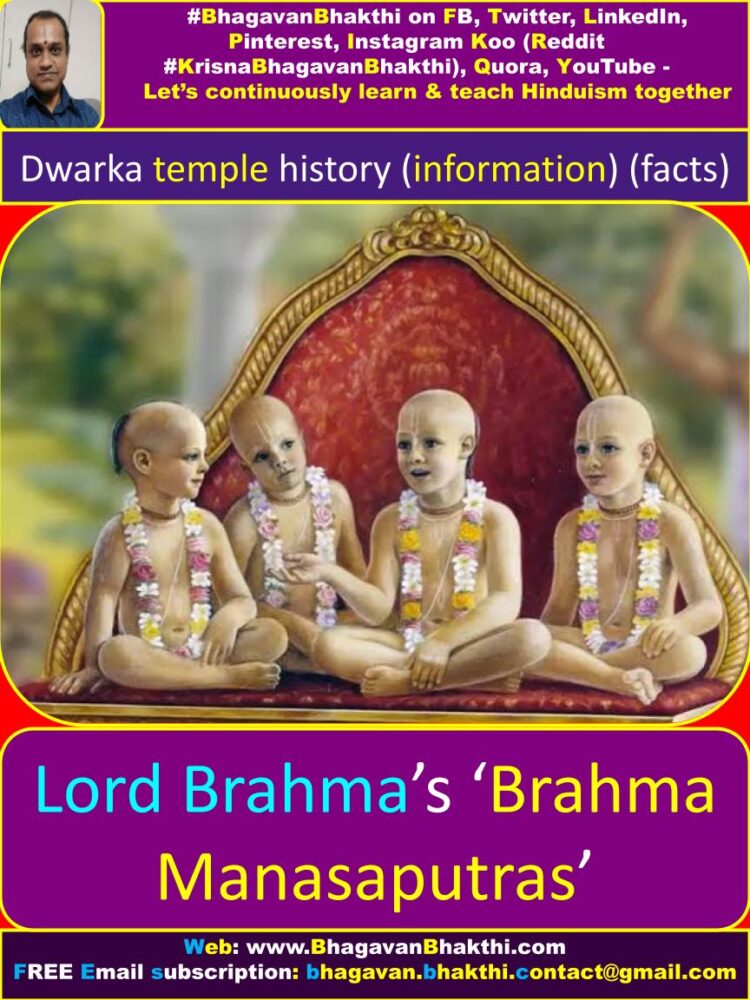
‘And sought their help in increasing the population of the world by becoming householders.’ ‘But, all of them were extremely virtuous and did not show any inclination towards getting married.’
‘Ultimately all of them went to the western coast and engaged themselves in austere penance.’ ‘Their penance continued for a number of years after which ‘Sudarshana Chakra‘ appeared before them.’
As all of them looked up in bewilderment, they heard a heavenly voice – ‘O sons of Lord Sri Brahma Deva! Very soon the almighty Lord Sri Vishnu is going to manifest himself.’
‘The ‘Chakra‘ you are seeing is his. You all must perform the rituals of ‘arghya‘ in the name of Lord Sri Vishnu to show your reverence towards him.’
All the Manasaputras eulogized Sudarshana Chakra with deep devotion. All of them wished that there were a holy river, with whose water they could perform the rituals of arghya.
But to their utter dismay there was no such holy river nearby. They then remembered Lord Sri Brahma Deva, who immediately understood what they desired.
Lord Sri Brahma Deva instructed Goddess Sri Ganga Devi by saying – ‘Ganga Devi! Go to the earth, where you would be known as Gomati.’
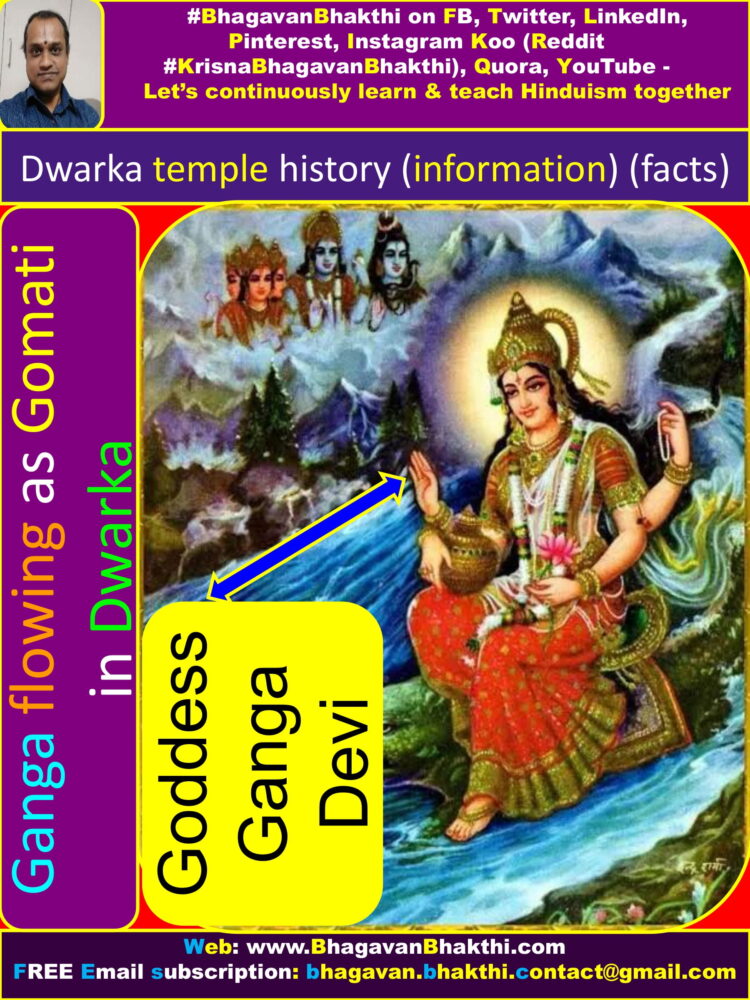
‘Sage Vashishtha Maharshi will lead you to your destination. Just follow him like a daughter follows her father.’
Finally, when sage Vashishtha Maharshi followed by Gomati reached their destination, all the Manasaputras were delighted. They eulogized Goddess Sri Ganga Devi and expressed their gratitude to Vashishtha Maharshi for bringing Sri Ganga Devi on earth.
All of them thanked Vashishtha Maharshi by saying – ‘Since you have brought Gomati on earth, you would be considered as her father.’
They offered ‘arghya‘ to Gomati and subsequently eulogized Lord Sri Vishnu.
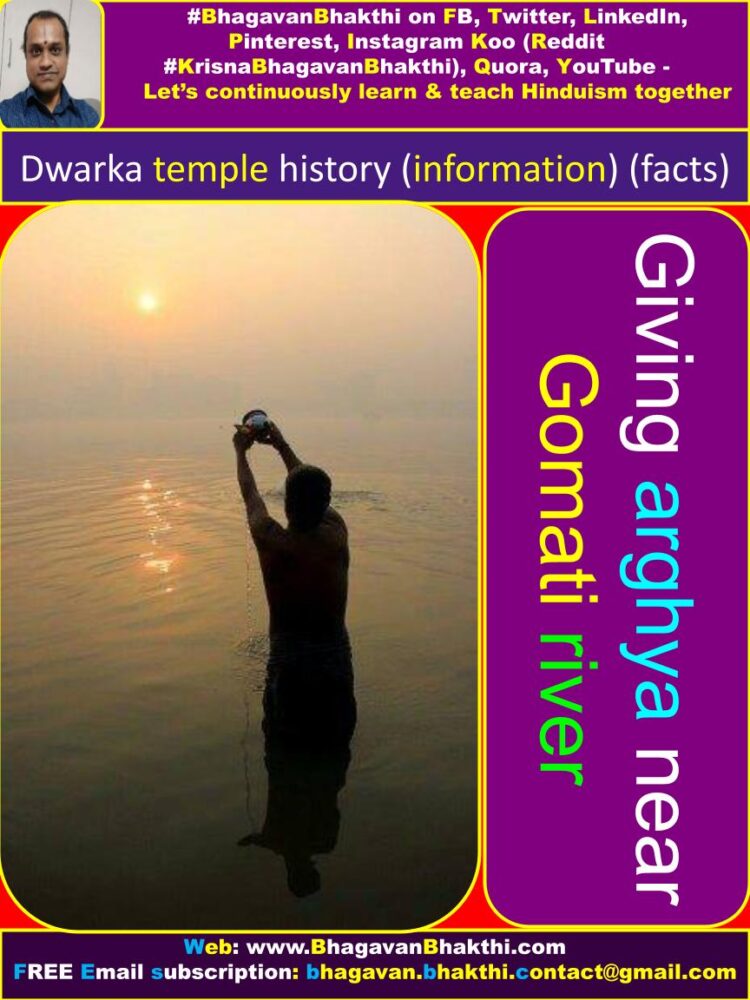
Lord Sri Vishnu appeared after being pleased and blessed them by saying – ‘Your unflinching devotion in me has pleased me no bound.’
‘Since you did this penance with the objective of Moksha (salvation), this place would become famous as ‘Moksha Dayak‘ (Moksha Dayaka) (giver of salvation).’
‘This sacrosanct place would also be called Chakra Tirtha because of Sudarshana Chakra, who informed you all of my manifestation a Dwarka Puri.’ ‘I assure you that I won’t abandon this sacrosanct place even for a moment.’
This way, all the Manasaputras were finally successful in their objective of offering arghya to Lord Sri Vishnu with the holy water of Gomati.
At last, Gomati having fulfilled her mission for which she had descended down to Earth merged with the ocean (Sri Varuna Deva). Lord Sri Vishnu disappeared from there and Manasaputras continued to live there.

More information will be added to this on regular basis. Please this post and other posts of this website / blog to get the updated information.
To watch videos on #Hinduism #Sanskrit language, SUBSCRIBE to my YouTube channel from this link: #BhagavanBhakthi YouTube channel
To know bout ‘Pilgrimage places (Tirtha Kshetras) in India‘, please click this link: Pilgrimage places (Tirtha Kshetras) in India
To know the “List of Brahma manasputras names“, visit this link: List of Brahma manasputras names
Dear friends, if you need any clarifications about this post, kindly let me know, I will definitely try to answer all of them.
Also your one LIKE, one COMMENT, One Share, one SUBSCRIPTION is highly important.
This will help to know the quality of this content and also it will be helpful to know if any improvements is required for the content.
If you feel this content is useful to you and has helped you to improve your knowledge, kindly share this with your well-wishers.
Because “SHARING MEANS CARING”.
For receive FREE EMAIL SUBSCRIPTION about #BhagavanBhakthi, you can send an email to bhagavan.bhakthi.contact@gmail.com from your email ID.
NAMASTE!
Sri Gurubhyo Namaha
Sri Dwarakadhishaaya Namaha
Sri Krishnaarpanamastu
Radhey Radhey
Jai Shree Radhey Krishna
Jai DwarikaDeesh
Jai Dwarika
Jai Sri Krishna
Shubhamastu!